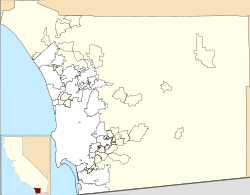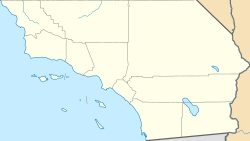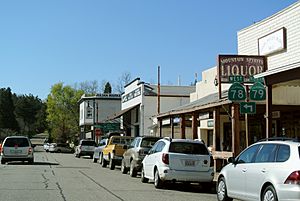Julian, California facts for kids
Quick facts for kids
Julian
|
|
|---|---|
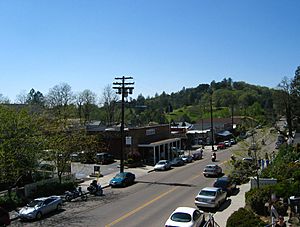
Main Street in Julian
|
|
| Motto(s):
"four seasons of beauty & fun..."
|
|
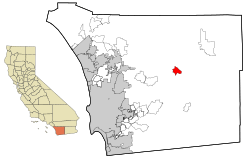
Location in San Diego County and the state of California
|
|
| Country | |
| State | |
| County | San Diego |
| Named for | Mike Julian |
| Area | |
| • Total | 7.839 sq mi (20.303 km2) |
| • Land | 7.839 sq mi (20.303 km2) |
| • Water | 0 sq mi (0 km2) 0% |
| Elevation | 4,226 ft (1,288 m) |
| Population
(2010)
|
|
| • Total | 1,502 |
| • Density | 191.61/sq mi (73.979/km2) |
| Time zone | UTC-8 (PST) |
| • Summer (DST) | UTC-7 (PDT) |
| ZIP code |
92036
|
| Area codes | 442/760 |
| FIPS code | 06-37582 |
| GNIS feature ID | 1652732 |
| Website | Julian Chamber of Commerce |
| Reference #: | 412 |
Julian is a census-designated place (CDP) in San Diego County, California. As of the 2010 census, the population was 1,502, down from 1,621 at the time of the 2000 census.
Julian is an official California Historical Landmark (No. 412). The Julian townsite and surrounding area is defined by the San Diego County Zoning Ordinance Section 5749 as the Julian Historic District. This designation requires that development adhere to certain guidelines that are administered by the Architectural Review Board of the Julian Historic District, which is appointed by the San Diego County Board of Supervisors.
The town is known for its apple pie and its annual Julian Apple Days Festival, which began in 1949.
Contents
History
The town was named by Drue Bailey after his cousin Mike Julian, who later was elected San Diego County Assessor.
The first European settlers were "Cockney Bill" Williams from England and John Wesley Horrell, who both arrived in the area in 1850 or 1851. After the American Civil War, in 1869, A.E. "Fred" Coleman, a former slave, was crossing over what is now known as Coleman Creek, just west of Julian. Seeing a glint of gold in the stream bed, he climbed down from his horse to investigate. Having had previous experience in the gold fields, he retrieved his frying pan and began panning the sands of the creek. Soon thereafter Coleman established the Coleman Mining District and was its recorder and also began the mining camp called Emily City later renamed Coleman City. Learning of the find, others rushed to the district and tried to trace the gold to its source. On February 22, 1870, the first "lode", or hard rock, mining claim was filed in the Julian area. Since February 22 was President George Washington's birthday, the mine was named the Washington mine. Soon hundreds of anxious men and families were rushing to Julian to stake their claims. Julian experienced a gold rush and became a tent city overnight. In April 1870, the area's first saw mill was set up and Julian began to take on a more permanent structure. Attempts to build rival mining towns at Coleman City, Branson City and Eastwood were defeated. Owners of the Cuyamaca rancho Land Grant claimed (the Cuyamaca Land Float) Julian and its mines were within the Rancho boundaries. In 1873, the courts ruled that the Rancho did not include Julian and the mines.
While the miners were trying to wrestle the gold from deep within the earth, James Madison brought a wagon load of young apple trees up into the mountains. The fruit trees flourished in the clear, fresh air. Apples are still a big product in Julian, many of which are used for making the world-famous Julian apple pies.
According to a bronze historical plaque appearing in the town, in the early days of Julian, the majority of San Diego County's African-American population resided in or near the town, including the founders of the Robinson Hotel as well as a noted resident, America Newton. Of the 55 blacks living in San Diego County during the 1880 census, 33 lived in the Julian area. (Although this information appears on the plaque, it has been the subject of some controversy.)
In recent decades Julian has become a quaint mountain resort. The town narrowly escaped destruction in the 2003 Cedar Fire that burned much of the surrounding area.
Geography
Julian is located in a mixed pine-oak woodland at 33°4′15″N 116°35′8″W / 33.07083°N 116.58556°W (33.070930, -116.585601), 4,235 feet (1,219 m) above sea level. Precipitation averages 26 inches (66 cm) per year, notably higher than rainfall totals in coastal and desert areas of San Diego County, due to the orographic effect.
According to the United States Census Bureau, the CDP has a total area of 7.8 square miles (20 km2), all land.
Soils in and around Julian are mostly dark brown, slightly to moderately acidic sandy loams which are well drained and of variable stoniness. Less stony areas, which underlie most of the townsite, are in the Holland series. The hills around town have rocky soils of the Crouch series. Somewhat poorly drained alluvial loam occurs along Coleman Creek.
Climate
Julian experiences more extreme temperatures and greater precipitation than much of southern California. It also receives snow in winter, which accumulates the most in March and can occur as late as April or even May. This attracts people from San Diego and other coastal cities, where it does not snow. Average yearly snowfall from 1893 to 2012 has been 22 inches (560 mm).
| Climate data for Julian, California (1981–2010 normals, snow and extremes 1893-present) | |||||||||||||
|---|---|---|---|---|---|---|---|---|---|---|---|---|---|
| Month | Jan | Feb | Mar | Apr | May | Jun | Jul | Aug | Sep | Oct | Nov | Dec | Year |
| Record high °F (°C) | 76 (24) |
77 (25) |
85 (29) |
90 (32) |
96 (36) |
106 (41) |
102 (39) |
100 (38) |
96 (36) |
92 (33) |
82 (28) |
73 (23) |
106 (41) |
| Average high °F (°C) | 52.9 (11.6) |
54.5 (12.5) |
59.0 (15.0) |
63.8 (17.7) |
71.4 (21.9) |
78.8 (26.0) |
85.6 (29.8) |
86.0 (30.0) |
81.9 (27.7) |
72.4 (22.4) |
59.6 (15.3) |
53.0 (11.7) |
68.2 (20.1) |
| Average low °F (°C) | 35.1 (1.7) |
35.1 (1.7) |
37.2 (2.9) |
40.1 (4.5) |
45.2 (7.3) |
51.8 (11.0) |
59.4 (15.2) |
59.1 (15.1) |
54.3 (12.4) |
47.7 (8.7) |
39.9 (4.4) |
35.5 (1.9) |
45.0 (7.2) |
| Record low °F (°C) | 14 (−10) |
15 (−9) |
17 (−8) |
24 (−4) |
30 (−1) |
33 (1) |
42 (6) |
36 (2) |
37 (3) |
27 (−3) |
19 (−7) |
15 (−9) |
14 (−10) |
| Average precipitation inches (mm) | 4.31 (109) |
5.82 (148) |
3.84 (98) |
2.10 (53) |
0.60 (15) |
0.13 (3.3) |
0.25 (6.4) |
0.47 (12) |
0.24 (6.1) |
1.36 (35) |
1.85 (47) |
3.58 (91) |
24.55 (623.8) |
| Average snowfall inches (cm) | 4.0 (10) |
5.0 (13) |
6.7 (17) |
2.6 (6.6) |
0.6 (1.5) |
0.0 (0.0) |
0.0 (0.0) |
0.0 (0.0) |
0.0 (0.0) |
0.0 (0.0) |
0.6 (1.5) |
2.5 (6.4) |
22 (56) |
Demographics
| Historical population | |||
|---|---|---|---|
| Census | Pop. | %± | |
| U.S. Decennial Census | |||
2010
The 2010 United States Census reported that Julian had a population of 1,502. The population density was 191.6 people per square mile (74.0/km2). The racial makeup of Julian was 1,341 (89.3%) White, 5 (0.3%) African American, 27 (1.8%) Native American, 12 (0.8%) Asian, 0 (0.0%) Pacific Islander, 81 (5.4%) from other races, and 36 (2.4%) from two or more races. Hispanic or Latino of any race were 195 persons (13.0%).
The Census reported that 1,502 people (100% of the population) lived in households, zero (0%) lived in non-institutionalized group quarters, and 0 (0%) were institutionalized.
There were 670 households, out of which 146 (21.8%) had children under the age of 18 living in them, 329 (49.1%) were opposite-sex married couples living together, 51 (7.6%) had a female householder with no husband present, 35 (5.2%) had a male householder with no wife present. There were 41 (6.1%) unmarried opposite-sex partnerships, and 4 (0.6%) same-sex married couples or partnerships. 209 households (31.2%) were made up of individuals, and 89 (13.3%) had someone living alone who was 65 years of age or older. The average household size was 2.24. There were 415 families (61.9% of all households); the average family size was 2.80.
The population was spread out, with 283 people (18.8%) under the age of 18, 76 people (5.1%) aged 18 to 24, 260 people (17.3%) aged 25 to 44, 585 people (38.9%) aged 45 to 64, and 298 people (19.8%) who were 65 years of age or older. The median age was 50.8 years. For every 100 females, 96.1 were males. For every 100 females age 18 and over, 95.4 were males.
There were 917 housing units at an average density of 117.0 per square mile (45.2/km2), of which 489 (73.0%) were owner-occupied, and 181 (27.0%) were occupied by renters. The homeowner vacancy rate was 3.0%; the rental vacancy rate was 9.5%. 1,065 people (70.9% of the population) lived in owner-occupied housing units and 437 people (29.1%) lived in rental housing units.
2000
As of the census of 2000, there were 1,621 people, 658 households, and 459 families residing in the CDP. The population density was 204.8 inhabitants per square mile (79.0/km2). There were 902 housing units at an average density of 114.0 per square mile (44.0/km2). The racial makeup of the CDP was 91.05% White, 1.17% Native American, 0.74% African American, 0.49% Asian, 0.12% Pacific Islander, 3.95% from other races, and 2.47% from two or more races. Hispanic or Latino of any race were 8.08% of the population.
There were 658 households, out of which 31.9% had children under the age of 18 living with them, 56.2% were married couples living together, 10.2% had a female householder with no husband present, and 30.2% were non-families. 24.3% of all households were made up of individuals, and 7.6% had someone living alone who was 65 years of age or older. The average household size was 2.46 and the average family size was 2.93.
In the CDP, the population was spread out, with 25.8% under the age of 18, 5.2% from 18 to 24, 22.6% from 25 to 44, 32.9% from 45 to 64, and 13.4% who were 65 years of age or older. The median age was 43 years. For every 100 females, there were 99.4 males. For every 100 females age 18 and over, there were 95.3 males.
The median income for a household in the CDP was $44,681, and the median income for a family was $49,143. Males had a median income of $32,105 versus $26,509 for females. The per capita income for the CDP was $18,132. About 4.3% of families and 6.6% of the population were below the poverty line, including 12.9% of those under age 18 and none of those age 65 or over.
Economy
The main employment sectors in Julian are tourism and agriculture, with emphasis on apples.
Education
The Julian Union School District operates one elementary, one junior high, one high school, and one Julian Charter School.
Infrastructure
Transportation
Access to Julian is limited to three major roads. The northern access is via State Route 79, which ultimately links to various other roads and highways serving northern San Diego and southwestern Riverside counties, including Interstate 15. State Route 78 comes to Julian from the west, providing access to Ramona and Escondido. The eastern access is State Route 78, which descends the eastern slope of the mountains to intersect with State Route 86 in Imperial County; this is the least commonly used of the three routes. The southern access is State Route 79 through Cuyamaca Rancho State Park, which provides a link to Interstate 8.
Notable people
- John Baca, decorated Vietnam War veteran and activist for homeless veterans
- Eleanor Burns, quilt maker, author, star of public television show
- A. E. Coleman, former slave who discovering gold in Julian
- James Hubbell, artist, architect, sculptor, and founder of the Ilan-Lael Foundation
- Don Kojis, former record-breaking, All-Star professional basketball player
- America Newton, former slave and pioneering African-American woman who helped launch the mining town
- Sig Ruman, German-American actor known for playing villains
- Don Winslow, screenwriter and New York Times bestselling novelist
See also
 In Spanish: Julián (California) para niños
In Spanish: Julián (California) para niños


